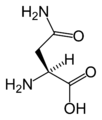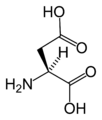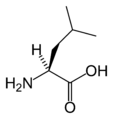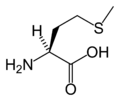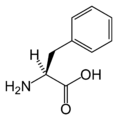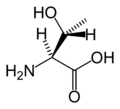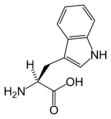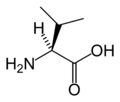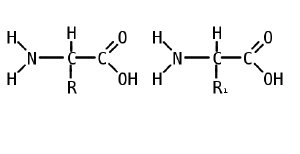An amino acid is an organic molecule with three main components: an amino group (-NH2), a carboxylic acid group (-COOH), and an R group, or side chain, unique to each amino acid.
Amino acids are the basic structural building blocks of proteins. Just as the letters of the alphabet can be combined in different ways to form an endless variety of words, a limited number of amino acids can be linked together in varying sequences to form a vast array of proteins. The unique three-dimensional shape of each protein, which results from the linear sequence of amino acids, determines the protein's specific function in the body.
Plants synthesize the amino acids that they require, utilizing carbon and oxygen from the air, hydrogen from water, and nitrogen that has been converted to usable form through nitrogen fixation. Animals can synthesize certain amino acids. Those important amino acids that cannot be synthesized by an animal, or at a rate sufficient to meet its physiological needs, and which therefore must be obtained from the diet, are called essential amino acids. The essential amino acids vary according to the type of animal. Although all vertebrates require certain amino acids that their cells cannot synthesize, ruminant animals (such as cattle) carry within one of the stomachs microbes that synthesize the amino acids needed by the animals. Amino acids reflect the interconnectedness of life, as the non-ruminant animals depend of plants for essential amino acids, ruminants depend on microbes within as a source, and even plants depend on bacteria to fix the nitrogen into a form that they can utilize to produce amino acids.
Although over 100 amino acids exist in nature, the human body requires 20 amino acids, called standard amino acids, for normal functioning. Approximately half of these standard amino acids are considered essential amino acids that cannot be synthesized and must be obtained from food.
Sources of amino acids
Standard amino acids
In humans, 20 amino acids are known as standard amino acids or proteinogenic amino acids. As the name "proteinogenic" (literally, protein building) suggests, these amino acid are encoded by the standard genetic code and participate in the process of protein synthesis. They are formed from an mRNA template in a process called translation, by which genetic information, encoded in the form of nucleic acids, is translated into the amino acids essential for protein synthesis. Combinations of these amino acids produce every single protein required for the homeostasis (i.e., the maintenance of a stable internal environment) of the human body.
L-Alanine (Ala / A)
L-Arginine (Arg / R)
L-Asparagine (Asn / N)
L-Aspartic acid (Asp / D)
L-Cysteine (Cys / C)
L-Glutamic Acid (Glu / E)
L-Glutamine (Gln / Q)
Glycine (Gly / G)
L-Histidine (His / H)
L-Isoleucine (Ile / I)
L-Leucine (Leu / L)
L-Lysine (Lys / K)
L-Methionine (Met / M)
L-Phenylalanine (Phe / F)
L-Proline (Pro / P)
L-Serine (Ser / S)
L-Threonine (Thr / T)
L-Tryptophan (Trp / W)
L-Tyrosine (Tyr / Y)
L-Valine (Val / V)
Chemical structures of the 20 standard amino acids.
Of these 20, 19 occur in nature as optically active, left-handed molecules because of the assymetrical central carbon atom, while one (glycine) is optically neutral. The standard amino acids thus exhibit the pattern 1 + 19. This 1 + 19 pattern is also found in nuclear chemistry, describing the twenty elements that occur as "pure isotopes"; one element (beryllium) has an even atomic number 4, and the other nineteen elements (F, Na, Al, P, Sc, Mn, Co, As, Y, Nb, Rh, I, Cs, Pr, Tb, Ho, Tm, Au, Bi) have odd atomic numbers. The same 1 + 19 pattern occurs among the twenty elements that occur as two stable isotopes. The correspondence of patterns at different levels of nature is one of the unsolved mysteries of science.[1]
Essential amino acids
Approximately half of the 20 standard amino acids are called essential amino acids because they cannot be synthesized by the human body from other compounds through chemical reactions; instead, they must be taken in with food. In humans, the essential amino acids are lysine, isoleucine, phenylalanine, leucine, methionine, tryptophan, threonine, and valine. Arginine and histidine may also be classified as essential amino acids, though they are generally considered essential only in children, whose undeveloped metabolisms are unable to synthesize them. Thus, the number of essential amino acids in humans is variously listed as 8 or 10.
The remaining standard amino acids are nonessential; although they can be obtained from food, the body can also synthesize them as needed.
Nonstandard amino acids
Aside from the 20 standard amino acids and two special amino acids, selenocysteine and pyrrolysine, which are coded by DNA in an atypical manner, there are a large number of nonstandard or non-proteinogenic amino acids. These latter are either not found in proteins (such as the amino acids carnitine, GABA, or L-DOPA), or they are not coded for in the standard genetic code (like hydroxyproline and selenomethionine) but they may result from the modification of standard amino acids after the protein has been formed in the translation stage of protein synthesis.
Some of these non-standard amino acids have been detected in meteorites, especially in a type known as carbonaceous chondrites, whose composition is considered to be representative of the solar nebula, or gaseous cloud, from which the solar system condensed. For example, over 79 amino acids were found in the primitive Murchison meteorite, a type of carbonaceous chondrite. Microorganisms and plants can also produce uncommon amino acids that can be found in peptidic antibiotics such as nisin, which is used as a food preservative.
The structure of amino acids
In biochemistry, the term "amino acid" is frequently used to refer specifically to alpha amino acids: those amino acids in which the amino and carboxylate groups are attached to the same carbon, the so-called α–carbon (alpha carbon). The general structure of these proteinogenic alpha amino acids is:
R
|
H2N-C-COOH
|
H
where R represents a side chain specific to each amino acid. The exception to this basic structure is proline, whose side chain cyclizes onto the backbone, forming a ring structure in which a secondary amino group replaces the primary amino group.
When amino acids join together to form proteins, the basic amino group and acidic carboxyl group are neutralized. Instead, the side chains of the amino acids determine the acid-base properties of proteins. Thus, amino acids are usually classified by two main chemical properties of the side chain: the charge of the R group (which determines whether the protein acts like a weak acid or a weak base), and its polarity (or tendency to interact with water at a neutral pH).
These properties influence the amino acids' interaction with other structures within the protein as well as their interaction with other proteins. For example, soluble proteins have surfaces rich with polar amino acids like serine and threonine. In contrast, integral membrane proteins tend to have an outer ring of hydrophobic amino acids (which do tend not to interact with water) that anchors them to the lipid bilayer. Similarly, proteins that have to bind to positively charged molecules have surfaces rich with negatively charged amino acids like glutamate and aspartate, while proteins binding to negatively charged molecules have surfaces rich with positively charged chains like lysine and arginine.
Isomers
Most amino acids occur in two possible optical isomers, called D and L. The L amino acids represent the vast majority of amino acids found in proteins. D amino acids are found in some proteins produced by exotic sea-dwelling organisms, such as cone snails. They are also abundant components of the proteoglycan cell walls of bacteria.
Amino acids' function in protein synthesis
Two amino acids are linked together by a peptide bond that forms when the basic amino group of one amino acid reacts with the acidic carboxyl group of a second amino acid. This condensation reaction (water loss) yields a peptide bond and a molecule of water. An amino acid residue is what is left of an amino acid once a molecule of water (an H+ from the amino group side and an OH- from the carboxylic side) has been lost in the formation of a peptide bond.
Proteins are then created by the polymerization of amino acids, a process in which amino acids are joined together in chains called, depending on their length, peptides or polypeptides.
Other biological roles of amino acids
In addition to their function in the formation of proteins, amino acids have other biologically-important roles. The standard amino acids glycine and glutamate, which are found in proteins, also function as neurotransmitters that respectively inhibit and amplify signals in the nervous system. The non-standard amino acid carnitine is used in lipid transport within the cell.
Many amino acids are used to synthesize molecules other than proteins:
- Tryptophan is a precursor of serotonin, a neurotransmitter important in the regulation of mood.
- Glycine is one of the reactants in the synthesis of porphyrins such as heme, which is a component of the hemoglobin molecules found in red blood cells.
- Arginine is used to synthesize the hormone nitric oxide.
Substances derived from amino acids have important uses in medicine and the food industry; for example:
- Aspartame (aspartyl-phenylalanine-1-methyl ester) is an artificial sweetener, and monosodium glutamate is a food additive that enhances flavor.
- 5-HTP (5-hydroxytryptophan) has been used to treat neurological problems associated with PKU (phenylketonuria), as well as depression (as an alternative to L-Tryptophan).
- L-DOPA (L-dihydroxyphenylalanine) is a drug used to treat the symptoms of Parkinson's disease.
Table of chemical properties
Following is a table listing the symbols and chemical properties of the standard amino acids. The mass listed is the weighted average of all common isotopes, and includes the mass of H2O. The one-letter symbol for an undetermined amino acid is X. The three-letter symbol Asx or one-letter symbol B means the amino acid is either asparagine or aspartic acid, whereas Glx or Z means either glutamic acid or glutamine. The three-letter symbol Sec or one-letter symbol U refers to selenocysteine. The letters J and O are not used.
Essential amino acids are marked with an asterisk.
| Abbrev. | Full Name | Side chain type | Mass | pI | pK1 (α-COOH) |
pK2 (α-+NH3) |
pKr (R) | Remarks | |
|---|---|---|---|---|---|---|---|---|---|
| A | Ala | Alanine | hydrophobic | 89.09 | 6.01 | 2.35 | 9.87 | Very abundant and versatile. It behaves fairly neutrally and can be located in both hydrophilic regions on the outside of the protein and hydrophobic interior areas. | |
| C | Cys | Cysteine | hydrophobic (Nagano, 1999) | 121.16 | 5.05 | 1.92 | 10.70 | 8.18 | The sulfur atom binds readily to heavy metal ions. Under oxidizing conditions, two cysteines can be joined together by a disulfide bond to form the amino acid cystine. When cystines are components of a protein, they enforce tertiary structure and makes the protein more resistant to unfolding and denaturation; disulphide bridges are therefore common in proteins that have to function in harsh environments, digestive enzymes (e.g., pepsin and chymotrypsin), structural proteins (e.g., keratin), and proteins too small to hold their shape on their own (eg. insulin). |
| D | Asp | Aspartic acid | acidic | 133.10 | 2.85 | 1.99 | 9.90 | 3.90 | Behaves similarly to glutamic acid. Carries a hydrophilic acidic group with strong negative charge. Usually is located on the outer surface of the protein, making it water-soluble. Binds to positively-charged molecules and ions, often used in enzymes to fix the metal ion. |
| E | Glu | Glutamic acid | acidic | 147.13 | 3.15 | 2.10 | 9.47 | 4.07 | Behaves similar to aspartic acid. Has longer, slightly more flexible side chain. |
| *F | Phe | Phenylalanine | hydrophobic | 165.19 | 5.49 | 2.20 | 9.31 | Phenylalanine, tyrosine, and tryptophan contain large rigid aromatic group on the side chain. These are the biggest amino acids. Like isoleucine, leucine and valine, they are hydrophobic and tend to orient towards the interior of the folded protein molecule. | |
| G | Gly | Glycine | hydrophobic | 75.07 | 6.06 | 2.35 | 9.78 | Because of the two hydrogen atoms at the α carbon, glycine is not optically active. It is the smallest amino acid, rotates easily, and adds flexibility to the protein chain. It is able to fit into the tightest spaces (e.g., the triple helix of collagen). | |
| *H | His | Histidine | basic | 155.16 | 7.60 | 1.80 | 9.33 | 6.04 | In even slightly acidic conditions, protonation of the nitrogen occurs, changing the properties of histidine and the polypeptide as a whole. It is used by many proteins as a regulatory mechanism, changing the conformation and behavior of the polypeptide in acidic regions such as the late endosome or lysosome, enforcing conformation change in enzymes. |
| *I | Ile | Isoleucine | hydrophobic | 131.17 | 6.05 | 2.32 | 9.76 | Isoleucine, leucine and valine have large aliphatic hydrophobic side chains. Their molecules are rigid, and their mutual hydrophobic interactions are important for the correct folding of proteins, as these chains tend to be located inside of the protein molecule. | |
| *K | Lys | Lysine | basic | 146.19 | 9.60 | 2.16 | 9.06 | 10.54 | Behaves similarly to arginine. Contains a long flexible side-chain with a positively-charged end. The flexibility of the chain makes lysine and arginine suitable for binding to molecules with many negative charges on their surfaces. (e.g., DNA-binding proteins have their active regions rich with arginine and lysine.) The strong charge makes these two amino acids prone to be located on the outer hydrophilic surfaces of the proteins. |
| *L | Leu | Leucine | hydrophobic | 131.17 | 6.01 | 2.33 | 9.74 | Behaves similar to isoleucine and valine. See isoleucine. | |
| *M | Met | Methionine | hydrophobic | 149.21 | 5.74 | 2.13 | 9.28 | Always the first amino acid to be incorporated into a protein; sometimes removed after translation. Like cysteine, it contains sulfur, but with a methyl group instead of hydrogen. This methyl group can be activated, and is used in many reactions where a new carbon atom is being added to another molecule. | |
| N | Asn | Asparagine | hydrophilic | 132.12 | 5.41 | 2.14 | 8.72 | Neutralized version of aspartic acid. | |
| P | Pro | Proline | hydrophobic | 115.13 | 6.30 | 1.95 | 10.64 | Contains an unusual ring to the N-end amine group, which forces the CO-NH amide sequence into a fixed conformation. Can disrupt protein folding structures like α helix or β sheet, forcing the desired kink in the protein chain. Common in collagen, where it undergoes a posttranslational modification to hydroxyproline. Uncommon elsewhere. | |
| Q | Gln | Glutamine | hydrophilic | 146.15 | 5.65 | 2.17 | 9.13 | Neutralized version of glutamic acid. Used in proteins and as a storage for ammonia. | |
| *R | Arg | Arginine | basic | 174.20 | 10.76 | 1.82 | 8.99 | 12.48 | Functionally similar to lysine. |
| S | Ser | Serine | hydrophilic | 105.09 | 5.68 | 2.19 | 9.21 | Serine and threonine have a short group ended with a hydroxyl group. Its hydrogen is easy to remove, so serine and threonine often act as hydrogen donors in enzymes. Both are very hydrophilic, therefore the outer regions of soluble proteins tend to be rich with them. | |
| *T | Thr | Threonine | hydrophilic | 119.12 | 5.60 | 2.09 | 9.10 | Behaves similarly to serine. | |
| *V | Val | Valine | hydrophobic | 117.15 | 6.00 | 2.39 | 9.74 | Behaves similarly to isoleucine and leucine. See isoleucine. | |
| *W | Trp | Tryptophan | hydrophobic | 204.23 | 5.89 | 2.46 | 9.41 | Behaves similarly to phenylalanine and tyrosine (see phenylalanine). Precursor of serotonin. | |
| Y | Tyr | Tyrosine | hydrophobic | 181.19 | 5.64 | 2.20 | 9.21 | 10.46 | Behaves similarly to phenylalanine and tryptophan (see phenylalanine). Precursor of melanin, epinephrine, and thyroid hormones. |
Notes
- ↑ Peter Plichta Plichta. God's Secret Formula: Deciphering the Riddle of the Universe and the Prime Number Code. Shaftesbury: Element Books, 1997. ISBN 1862040141
ReferencesISBN links support NWE through referral fees
- Doolittle, R. F. 1989. Redundancies in protein sequences. In Predictions of Protein Structure and the Principles of Protein Conformation, ed. G.D. Fasman, 599-623. New York, NY: Plenum Press.
- Nelson, D. L., and M. M. Cox. 2000. Lehninger's Principles of Biochemistry, 3rd edition. New York, NY: Worth Publishers.
- Naganoa, N., O. Motonori, and K. Nishikawa. 1999. Strong hydrophobic nature of cysteine residues in proteins. FEBS Letters 458(1):69-71. On the hydrophobic nature of cysteine.
Credits
New World Encyclopedia writers and editors rewrote and completed the Wikipedia article in accordance with New World Encyclopedia standards. This article abides by terms of the Creative Commons CC-by-sa 3.0 License (CC-by-sa), which may be used and disseminated with proper attribution. Credit is due under the terms of this license that can reference both the New World Encyclopedia contributors and the selfless volunteer contributors of the Wikimedia Foundation. To cite this article click here for a list of acceptable citing formats.The history of earlier contributions by wikipedians is accessible to researchers here:
The history of this article since it was imported to New World Encyclopedia:
Note: Some restrictions may apply to use of individual images which are separately licensed.



